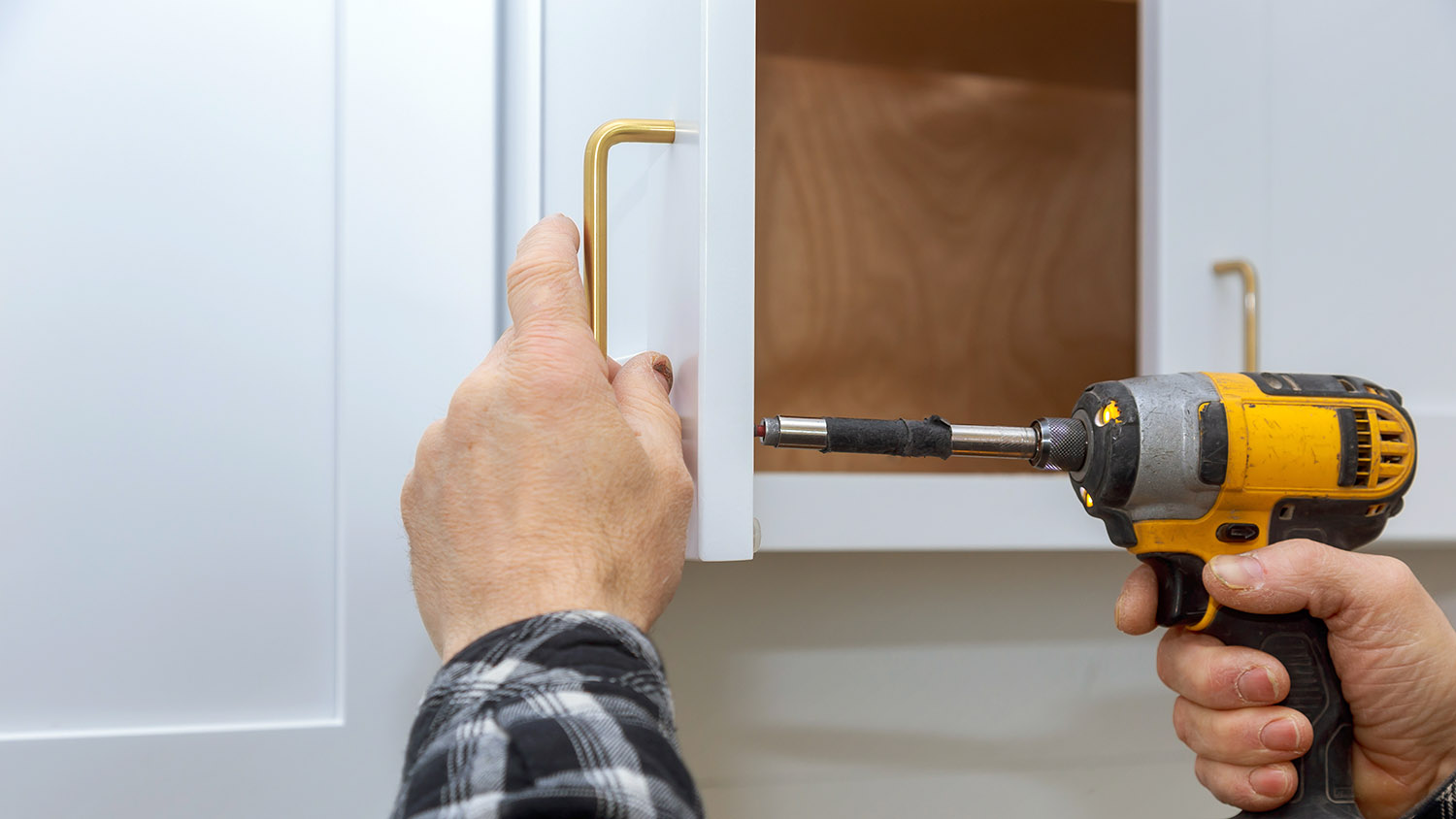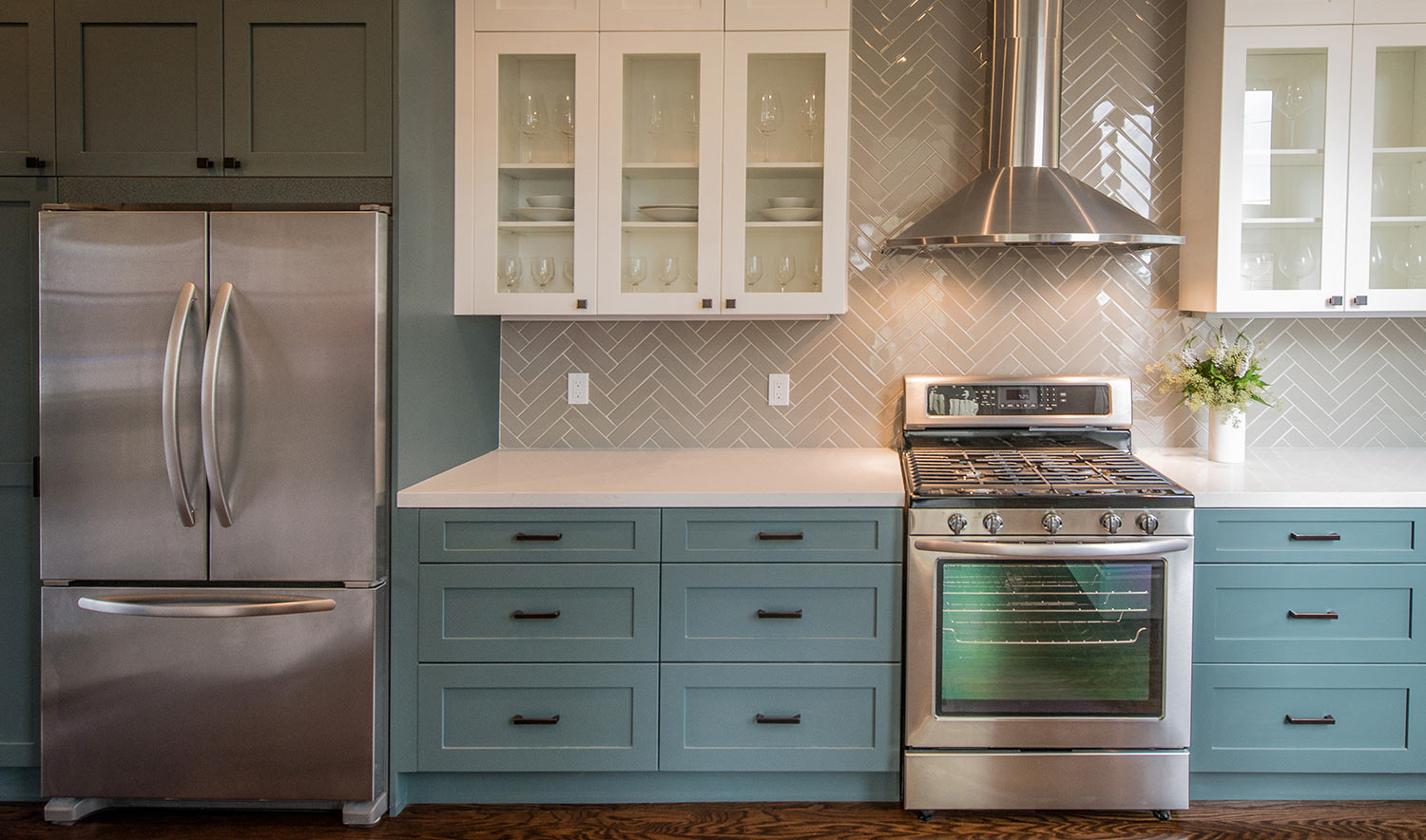
Use this guide to budget for pressure washing your deck based on cost factors such as deck size, material, potential repairs, and additional services.
Cabinet installation costs an average of $6,309


The average cabinet installation cost is $6,309, although projects can range from as low as $200 for a single cabinet to as high as $30,000 for a high-end kitchen.
Material, kitchen size, and cabinet placement significantly influence the final price.
Installing new cabinets rejuvenates a kitchen’s style while adding practical storage solutions.
Hiring a skilled professional means precise measurements, durable materials, and a polished, ready-to-use kitchen.
This article was updated using automation technology and thoroughly reviewed for accuracy by HomeAdvisor Editor Ryan Noonan.
The average cost range to install kitchen cabinets ranges between $1,975 and $11,042, with an average cabinet installation cost of $6,309. Installing a single cabinet can cost as little as $200, while a large kitchen with fully custom, high-quality cabinets can run as high as $30,000 or more.
The most significant factor affecting the cost of replacing kitchen cabinets is the type of cabinet you choose: stock, semi-custom, or fully custom. Additional factors that impact your cabinet replacement cost include the material of the cabinets and the size of your kitchen.
Your final cabinet price hinges on a variety of factors. Here’s a closer look at how your cabinet installation cost breaks down.
While local kitchen designers don’t calculate the cost to install kitchen cabinets by the square footage of your kitchen, it can be a good starting place if you’re looking for a rough estimate before getting quotes.
The table below shows the average prices for stock or semi-custom cabinets. Custom cabinets would increase these costs by 50% to 100%.
| Kitchen Size (Feet) | Average Cost Range |
|---|---|
| Small (10x10) | $2,000–$24,000 |
| Average (12x12) | $2,400–$28,800 |
| Large (12x15) | $2,700–$32,400 |
Another way of estimating how much installing kitchen cabinets costs is by linear foot. Most kitchen cabinet installation costs between $100 and $1,200 per linear foot, depending on the cabinet's depth, material, and style. Knowing the general linear length can help your pro give you a ballpark estimate, especially once you settle on a design.
The average kitchen has 24 linear feet of cabinets, which yields an average cabinet installation cost of $2,400 to $28,000 in total, depending on the level of customization, material, and style.
The materials you choose also impact your final cabinet installation costs. Solid wood tops the popularity list, but wood veneer and laminate offer similar looks at a friendlier price. These non-wood alternatives often mimic wood, and they're a durable choice. However, they're difficult to repair when damaged (meaning higher cabinet repair costs) and lack the richness and authenticity of real wood.
The following table outlines the average cost for stock cabinets of each material:
| Material | Average Cost Range |
|---|---|
| Wood | $5,000–$25,000+ |
| Wood veneer | $2,000–$15,000+ |
| Laminate | $4,000–$15,000 |
| Acrylic | $5,000–$20,000 |
| Stainless steel | $25,000–$38,000 |
New cabinet hardware costs anywhere from $2 to $50 per piece. Stock cabinets include hinges, which should appear as a line item in quotes. When you hire a kitchen remodeling contractor, they include all hardware in their project costs. If you’re unsure, have the contractor flag these charges in the estimate before you sign.
Basic stock cabinets don't offer many diverse design elements, but if you consider semi-custom and fully custom cabinets, you can enhance their design with trim and molding. Crown molding costs between $2 and $3 per linear foot.
Under-cabinet lighting is another way to improve the aesthetic and functionality of your kitchen. Under-cabinet lighting costs between $230 and $300 per light.
Shifting cabinet locations won’t raise cabinet or installation costs, but it can trigger extra work behind the walls. However, you’ll have to consider the costs associated with moving electrical outlets, plumbing, redoing drywall, and painting.
Drywall patching costs $300 to $900. Opening walls to move plumbing or electrical generally requires this type of wall repair.
If you need to relocate plumbing lines, expect your plumber to charge between $45 and $200 per hour.
If you need to move electrical wiring, electricians charge $50 to $100 per hour.
You’ll spend between $50 and $450 per linear foot on labor for hanging cabinets, depending on the type of cabinet you choose.
Removing old cabinets runs between $350 and $800, and can reach up to $1,000 for large kitchens, on top of the other cabinet installation costs.
To simplify cabinet cost estimates, we can break down cabinets into three types: stock, semi-custom, and custom.
| Cabinet Type | Average Cost per Linear Ft. |
|---|---|
| Stock (pre-made) | $100–$300 |
| Semi-custom | $150–$650 |
| Custom | $500–$1,200 |
| High-end custom | $13,000–$30,000 |
Fully installed, stock cabinets cost $100 to $300 per linear foot. You may have a few choices of different colors or trim styles within the stock category. Prices are low because the cabinets are manufactured in large quantities.
With labor factored in, expect to spend between $150 and $650 per linear foot on semi-custom cabinets.
Semi-custom cabinets can serve as an excellent compromise between stock and custom for price and flexibility, including the following:
More flexibility than stock options
Offered in a few popular traditional and contemporary styles with limited finishes
Ability to choose from different sizes with semi-custom options within standard dimensions
Custom cabinets can cost as much as $1,200 per linear foot. As the name suggests, these let you truly customize your kitchen.
You can get cabinets that fit odd-shaped rooms and appeal to the most eccentric tastes, but such cabinets tend to be more expensive. With custom cabinets, you're buying a one-of-a-kind piece. Local cabinetmakers may regard their work more as art than furniture.
Refacing cabinets costs $80 to $500 per square foot, depending on your cabinet material. Refacing cabinets instead of installing new ones could significantly reduce project costs while giving your kitchen an updated look. To reface cabinets, a pro removes the doors and drawers, installs a wood veneer or laminate over the existing cabinet (sometimes called a "skin"), and installs new doors and fronts to match. New fixtures and hinges may be added to elevate the design.
Another option is to skip the reskinning and replace the doors and hardware. Whether replacing specific elements or refacing the entire cabinet, it's an environmentally friendly choice that reduces the waste of installing entirely new cabinets each time you update your kitchen.
Refinishing cabinets costs an average of $3,100 for an entire kitchen. Refinishing cabinets is a more economical way to update the look and feel of your kitchen without waste. However, refinishing doesn't last as long as refacing or replacing.
Installing cabinets is labor‑intensive, but you still have several ways to keep the project on budget:
Opt for stock cabinets: Stock cabinets are significantly more affordable than custom models and come in many stylish designs. Talk to your contractor about the best places to shop for stock cabinets.
Look for upcycled options: Materials costs are a major factor in kitchen cabinet installation, so anything that can save on materials will reduce your total cost. Contractors often donate gently used cabinets, including custom models and other high-quality materials. Browse places like Habitat for Humanity for upcycled cabinets that can save you money and reduce materials use.
Consider refacing or refinishing: If your current cabinets show some wear and tear but are still structurally sound, it may be better to reface or refinish rather than fully replace your cabinets. A nice stain can completely transform the look of your cabinets at a more affordable price.
Contact multiple pros: Reach out to several cabinet contractors in your area to compare quotes and find the best fit for your project.
No place is more important than your home, which is why HomeAdvisor connects homeowners with local pros to transform their houses into homes they love. To help homeowners prepare for their next project, HomeAdvisor provides readers with accurate cost data and follows strict editorial guidelines. We surveyed thousands of real customers about their project costs to develop the pricing data you see, so you can make the best decisions for you and your home. We pair this data with research from reputable sources, including the U.S. Bureau of Labor Statistics, academic journals, market studies, and interviews with industry experts—all to ensure our prices reflect real-world projects.
From average costs to expert advice, get all the answers you need to get your job done.

Use this guide to budget for pressure washing your deck based on cost factors such as deck size, material, potential repairs, and additional services.

Budget for custom cabinet installation by exploring how their size, materials, features, and labor requirements affect your final bill.

Unsure who installs kitchen cabinets? Learn whether to hire a cabinet installer, a general contractor, or a carpenter, and see how pros get it done.

Learn if you should hire a cabinet installer or handyperson, what to expect, and how much installation costs.

Unsure who to hire to build custom cabinets? Learn when to call a cabinet maker, other pro options, and custom cabinets cost ranges.

If you plan to refinish your cabinets, budget based on essential cost factors, including size and number of cabinets, finishing type, and labor costs.